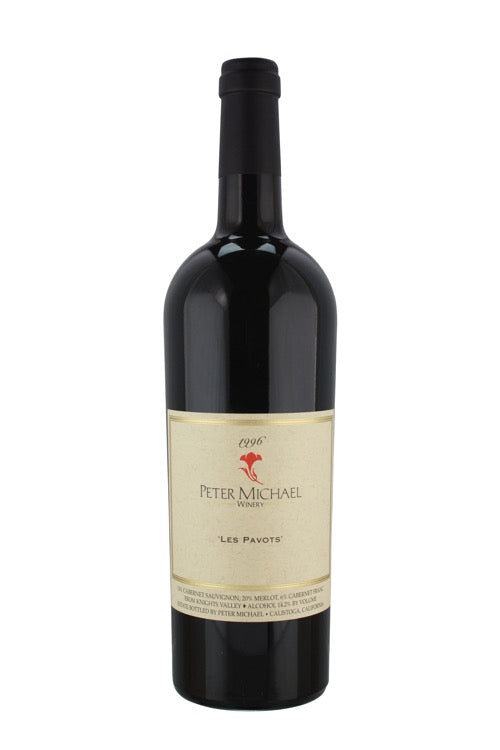1
/
of
1
- Home
- Wines: Cabernet Sauvignon
- Peter Michael Les Pavots Proprietary Red Wine - 1996 (750ml) *Damaged Label*
Peter Michael Les Pavots Proprietary Red Wine - 1996 (750ml) *Damaged Label*
Peter Michael Les Pavots Proprietary Red Wine - 1996 (750ml) *Damaged Label*
Regular price
$239.99
Sale price
$239.99
Regular price
$239.99
Unit price
/
per
The powerhouse, opaque purple/blue-colored 1996 Les Pavots is a blend of 74% Cabernet Sauvignon, 20% Merlot, and 6% Cabernet Franc. The nose offers up blackberry, licorice, cassis, and pain grille aromas. The superb extract, well-defined personality, and smoky, licorice, Asian spice, and blackberry flavors provide a thrilling tasting experience. It was bottled with neither fining nor filtration. There are approximately 2,800 cases of this fabulous effort. Anticipated maturity: now-2025.
Robert Parker - 96 points
Robert Parker - 96 points
Availability:
1 In Stock
$25 Shipping on Orders +$299
Couldn't load pickup availability
Share :

- varietal
- Region
- Sub - Region
- Type
- Reviews
Product Review
The powerhouse, opaque purple/blue-colored 1996 Les Pavots is a blend of 74% Cabernet Sauvignon, 20% Merlot, and 6% Cabernet Franc. The nose offers up blackberry, licorice, cassis, and pain grille aromas. The superb extract, well-defined personality, and smoky, licorice, Asian spice, and blackberry flavors provide a thrilling tasting experience. It was bottled with neither fining nor filtration. There are approximately 2,800 cases of this fabulous effort. Anticipated maturity: now-2025.
Product Score
96
Cabernet Sauvignon is one of the most prominent dark-skinned grape varieties except Merlot in terms of area under vines, but which comprises our largest selection of wines. Grown in just about every wine producing region and climate, Cabernet Sauvignon can express a huge range of aromas, from green peppers in cool climates through to dark jammy fruit in hot regions. Common aromas include blackcurrants, mint, graphite, and forest floor, to name a few. Maturation in small oak barrels can develop a complex range of aromas from cedar wood, cigar box and tobacco to eucalyptus and undergrowth. Cabernet Sauvignon’s success is partly due to its ability to adapt to a range of soils and climates. It is the main constituent of the Bordeaux blend in the revered communes of Pauillac, St. Estephe and St. Julien, and has achieved equal success in California’s Napa Valley. It is grown extensively throughout Southern Australia, with some outstanding examples from the Terra Rossa soil of Coonawarra. Cabernet Sauvignon also plays an increasing role in Tuscany, Italy, where it is blended with native varieties such as Sangiovese to produce the Super Tuscans.
California is one of the most diverse wine producing regions of the world. Although it has a history spanning over 200 years, it has experienced most of its growth in the last fifty years. The regions of Napa Valley and Sonoma County have become as renowned as France’s Bordeaux and Burgundy. While Cabernet Sauvignon, Pinot Noir, and Chardonnay are by far the most popular fine wine varieties, producers in the Golden State have also experimented with an unparalleled array of diverse varieties, including Zinfandel, Syrah, Nebbiolo, Sangiovese, and Tempranillo.
With a wide range of climate and soils reflected in its 13 AVAs (as of 2012), Sonoma County could almost be considered a whole wine country within itself. It is one of the largest wine regions and significantly overshadows Napa in terms of quantity produced. The main AVAs include: Alexander Valley and Dry Creek, known for good Sauvignon Blanc and Zinfandel; Knights Valley and Sonoma Mountain, for its Cabernet Sauvignon; and Russian River Valley, Sonoma Coast, Sonoma Mountain, for their Chardonnay and Pinot Noir.
Red wine is wine made from dark-coloured grape varieties. The color of red differs based on the grapes variety or varieties used.Interestingly, black grapes yield a juice that is greenish-white. The actual red color comes from anthocyan pigments (also called anthocyanins) from the skin of the grape (exceptions are the relatively uncommon teinturier varieties, which produce a red colored juice). Most of the production centers around the extraction of color and flavor from the grape skin.


